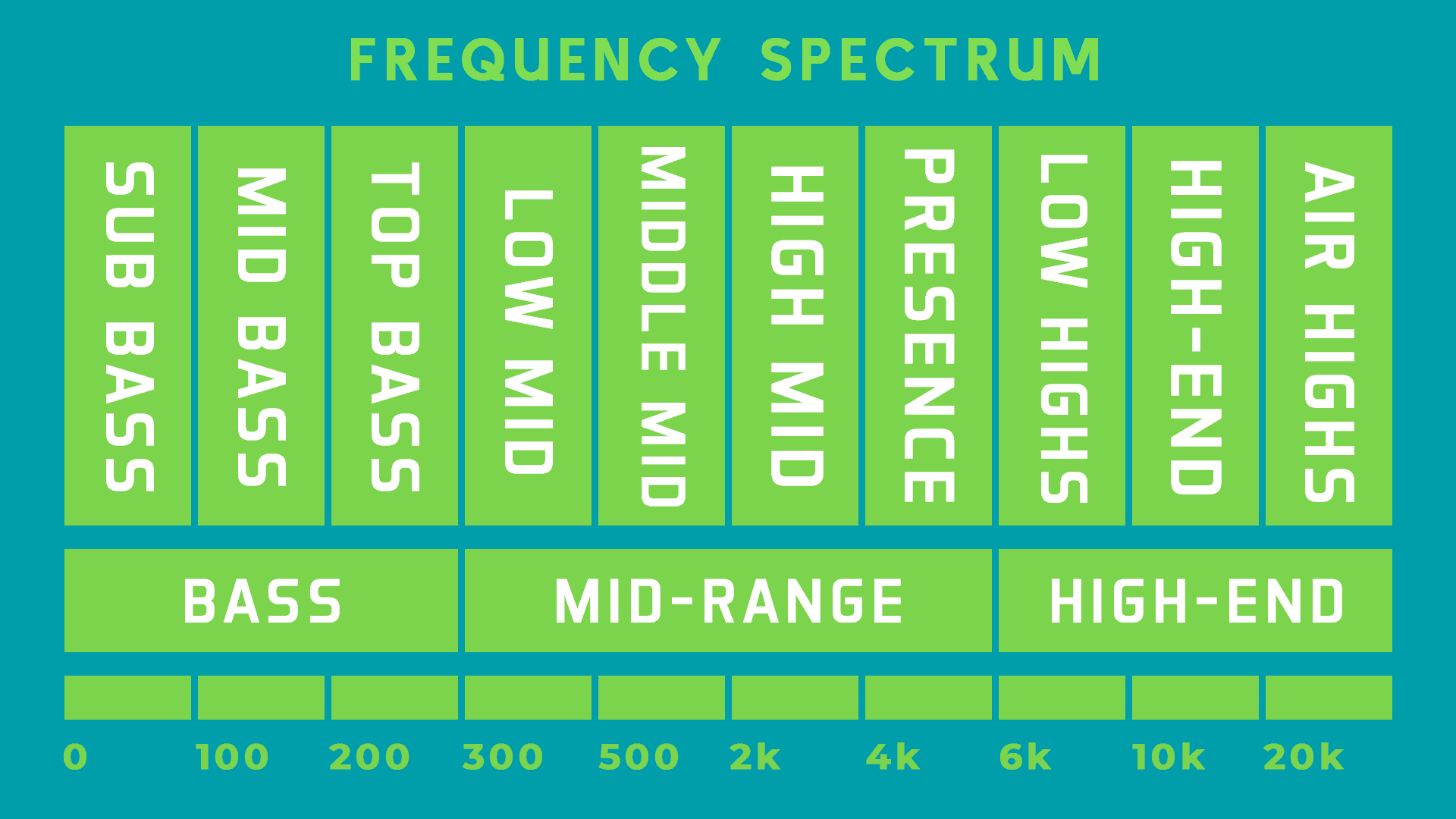Vocals are one of the most important elements in any song, so you have to make sure that you mix them properly.
Equalizing male vocals can be challenging. Especially when their bass is strong, or when they have harsh frequencies.
There are three main areas you need to know to equalize vocals. The first area is the bass (0hz – 250hz), the second is the low-mid (250hz – 600hz), and the third is the brilliance (6kHz – 20kHz).
Normally, you’ll need to lower the bass, remove harsh frequencies and muddiness from the mid-range, and slightly boost the brilliance frequencies.
In this article, I’ll review these areas and some more important ones, and tell you what exactly you should do according to your goals when equalizing them.
Principles You Should Know
- Principle #1: Make Things Right From The Beginning – Before you start recording, take a minute to think about how you want the final vocals to sound like, and plan things accordingly.For example, if you want the vocals to be bright and clear, use a diaphragm condenser microphone, and get a bit further from the microphone (5-10 inches).
But, if you want a warm and close sound, use a dynamic microphone, get closer to the microphone (2-5 inches).
- Principle #2: Avoid The Solo Button – In the end, the most important thing is the context of the vocals with the song.And even though the changes you make when on the vocals sound great on solo, it doesn’t necessarily mean that they will sound good in the mix. Therefore, try to avoid it as much as you can.
The only time you should listen to the vocals in solo is when you try to remove resonating frequencies.
- Principle #3: Always Cut Before You Boost – When you’re cutting frequencies, you’re reshaping the vocals, and you clear some space.After you remove frequencies that were too strong, you make room for the other frequencies to pop, and you may find out that you don’t need to boost anything at all.

Frequencies You Should Reduce
There are two kinds of things you have to use when you’re equalizing male vocals.
The first is using high-pass and low-pass filters to cut frequencies completely, and the second is lowering/boosting frequencies.
- Remove The Sub-Bass (0Hz – 100Hz) – You need to remove all the unnecessary frequencies completely. These frequencies are usually at (0hz-100hz).Apply a high-pass filter up to the point where you hear the vocals get thinner.
By eliminating these frequencies, you make your track cleaner and tighter, and you clear the space for the actual bass.
- Lower The Bass (100Hz – 250Hz) – You need to lower all the bass frequencies that are taking too much space in the mix. Usually, they’re at (100hz-250hz).You cut those frequencies because the vocals basically don’t belong to the bass, but, of course, there are exceptions.
If you want the vocals to sound heavy and “in your face,” you shouldn’t lower the bass. Another thing that I find especially helpful is using dynamic equalizers.
Dynamic equalizers are the combination of an equalizer and a compressor. They allow you to lower the bass only when it goes over a certain threshold.
This way, you can make a well-balanced sound without messing with automation.
- Clear ResonatingHarsh Frequencies (300Hz – 20kHz) – Pretty much every recording you’ll ever make will have some resonating frequencies. And they can easily ruin amazing records. So It’s important to treat them correctly.To do so, make a bell band with high bandwidth, and a high gain (about +10dB).
After you have created it, go over your frequencies and try to find the resonating frequency that’s bothering you.
It would help to take a moment and decide how this frequency sounds like.
if it sounds fat and low – (300Hz-600Hz), if it sounds sort of like a whistle – (600Hz-4kHz), if it sounds kind of like a sharp air – (4kHz-20kHz).If you’re still having a hard time finding the right frequencies to eq, I highly recommend that you start using these excellent ear training methods of “TrainYourEars”.
They will let you take a self suited training series that will make a massive change to your hearing and production skills.
Frequencies You Should Boost
The frequencies you boost come down to your preferences and your mixes. However, there are some common areas you should know about.
The Mid-Range Frequencies (500Hz – 2kHz)
Boosting these frequencies can give your vocals extra crunchiness. You should boost them if you feel like the vocals lack some power.
But notice that you should be extra careful when boosting these frequencies.
The human ear is super sensitive to these frequencies, so only boost them if you have to.
The Upper Mid-Range Frequencies (2kHz – 4kHz)
The human hearing is mainly centered at the upper midrange frequencies, so it’s crucial that you balance those correctly.
These frequencies are mostly responsible for the attack, but they can also add presence when they’re boosted.
Boosting these frequencies can make your vocals stand out a lot more, but if you boost them too much, they can also cause listening exhaustion.
The Presence Frequencies (4kHz – 8kHz)
These frequencies are responsible for the clarity of the vocals. These are also the frequencies that most home stereos center their treble control on.
If you want to make your vocals stand out a bit more, you should try and boost these frequencies.
Start by adding a wide boost of about 2-3dB and fine-tune it from there.
The Brilliance Frequencies (8kHz – 20kHz)
These frequencies are responsible for the sparkle and air sound of the vocals.
If you want to increase the spark of the vocals, boost around (12kHz-15kHz). Boosting these frequencies will make your vocals pop instantly.
However, if you boost them too much, they might make your vocals a bit harsh, so be cautious when boosting them. Usually, a 2dB-4dB boost is the perfect amount.
5 Common Mistakes And How To Fix Them
- Making Automatic Actions – By “automatic actions,” I mean the acts that you make even before you listen to the track.Such as – high-passing everything up to 100hz. You have to remember that there is no straight pattern for mixing.
Every track is a little different. Therefore, every track needs a different treatment. So, instead, listen to each track carefully and make intentional choices.
- Ignoring The Context – Don’t forget that your final goal is to make your mix sound great, so your final choices must be made while hearing how your vocals interact with other tracks in your mix.So try to avoid the solo button while you’re equalizing, but don’t avoid the solo button completely.
It’s ok to use it when you need to be specific, but always check how the changes you make affect the mixdown.
- Avoiding Extreme Decisions – There is some advice out there that tells you to avoid extreme eq decisions, and that’s great most of the time.But there are situations when you absolutely need to make those decisions. So, bottom line, the best thing you can do is to trust your ears.
Bonus tip: Use reference tracks and compare your vocals with already equalized professional vocals. This way, you can make sure that you’re doing the right thing.
- Over Equalizing – In most genres, you’d probably want the vocals to sound natural and realistic. So don’t over equalize.If you do, you might find yourself dealing with vocals that sound robotic and unpleasant. However, you should also remember tip number 3, always trust your ears.
A great thing I like doing is setting the vocals’ tone how I want before I record them.
You can do that by setting the right mic placement and trying to find a great recording room.
- Cutting the low-end instead of lowering it – This is a mistake that most beginners do when they hear vocals with heavy bass.Cutting up too high will make your vocals sound thin and dull. But not cutting at all will leave some unnecessary frequencies.
So, the best thing to do is to both cut and lower.
Usually, what I’ll do is cut everything from 0Hz up to 80Hz-120Hz, and if I feel the vocals need it, I’ll also lower 120Hz-250Hz.







